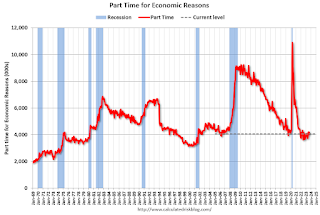by Calculated Risk on 10/06/2023 09:27:00 AM
The headline jobs number in the September employment report was well above expectations, and employment for the previous two months was revised up by 119,000, combined. The participation rate and the employment population ratio were both unchanged, and the unemployment rate was also unchanged at 3.8%.
Leisure and hospitality gained 96 thousand jobs in September. At the beginning of the pandemic, in March and April of 2020, leisure and hospitality lost 8.2 million jobs, and are now down 184 thousand jobs since February 2020. So, leisure and hospitality has now added back about 98% all of the jobs lost in March and April 2020.
Construction employment increased 11 thousand and is now 406 thousand above the pre-pandemic level.
Manufacturing employment increased 17 thousand jobs and is now 226 thousand above the pre-pandemic level.
| Headline Jobs, Top 10 Streaks | ||
|---|---|---|
| Year Ended | Streak, Months | |
| 1 | 2019 | 100 |
| 2 | 1990 | 48 |
| 3 | 2007 | 46 |
| 4 | 1979 | 45 |
| 5 tie | 1943 | 33 |
| 5 tie | 1986 | 33 |
| 5 tie | 2000 | 33 |
| 5 tie | 20231 | 33 |
| 9 | 1967 | 29 |
| 10 | 1995 | 25 |
| 1Currrent Streak | ||
Prime (25 to 54 Years Old) Participation
Since the overall participation rate is impacted by both cyclical (recession) and demographic (aging population, younger people staying in school) reasons, here is the employment-population ratio for the key working age group: 25 to 54 years old.
The 25 to 54 participation rate was unchanged in September at 83.5% from 83.5% in August, and the 25 to 54 employment population ratio declined to 80.8% from 80.9% the previous month.
Average Hourly Wages

Wage growth has trended down after peaking at 5.9% YoY in March 2022 and was at 4.2% YoY in September. On an annualized basis, wages increased 2.5% in September.

“The number of persons employed part time for economic reasons, at 4.1 million, changed little in September. These individuals, who would have preferred
